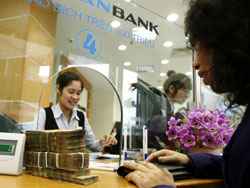|
Bank credit quality comes under scrutiny
Experts have recommended that the State Bank of Viet Nam (SBV) adopt measures to inspect credit quality at banks, along with increasing credit-growth quotas for credit institutions.

Of the nation's 62 credit institutions, 23 have petitioned the SBV to increase their credit-growth quotas, Tuoi Tre newspaper reported.
Last week, SBV increased the quotas for 10 financially healthy banks that have met more than 50 per cent of credit-growth quotas allocated by the SBV earlier this year.
TienPhong Bank and Dai Duong Bank (Ocean Bank), for instance, were allowed to enjoy the credit-growth limit of 27 per cent, while HCM City Development Bank (HDBank), a quota of 30 per cent.
According to the SBV, it would be difficult for banks to meet the new credit-growth target in current economic difficulties, as it would depend on how enterprises solve their unsold inventory and on their capacity to expand in the markets.
If banks meet their credit-growth quotas, credit growth for the entire banking sector this year would not exceed 8-10 per cent. Inflationary pressure would not occur, according to the SBV.
However, experts said that it could cause inflation next year, and they have asked the SBV to enhance the inspection of credit quality.
Vu Dinh Anh at the Institute for Economics and Finance under the Ministry of Finance said this year's credit growth target of 8-10 per cent was not high.
However, in the first half of the year, credit in the commercial banking sector grew by an average of only 1.51 per cent.
So, to meet the credit-growth target, the commercial banking sector needs a rapid increase of credit growth for the remainder of the year, which could cause inflation.
Anh said that inflation would probably not occur until next year since monetary policies always have a delayed effect.
Loosening credit would affect the property market, but it would not cause a property boom, according to Anh.
In addition to inspecting credit quality at banks, he said the SBV should also check credit growth for the property sector.
Economist Huynh Buu Son said expanding credit growth was necessary if the economy showed signs of deflation and low credit growth.
However, he cautioned that banks must offer loans to the right customers.
In current conditions, banks are reluctant to pump more capital in the property sector, and will only lend to production and trading companies, according to Son.
Increasing credit growth by 30-40 per cent at small banks does not equal to a few per cent of credit growth at large banks, so this would not adversely affect the economy or worsen inflation, another expert said.
The problem is the quality of loans. The SBV should have regulations stipulating clearly the lending conditions in each sector and the limitations on lending in certain sectors, he said.
A bank general director, whose bank was approved to increase credit-growth quotas, said his bank would control its credit-growth rate in accordance with its capital mobilisation capacity, and would improve credit quality to ensure safety for its banking system.
He said his bank would not meet the credit growth target at any cost.
Nguyen Huu Dang, general director of HDBank, said his bank had plans to allocate more credit to the agricultural sector, small- and medium-d enterprises and household businesses.
Trinh Van Tuan, chairman of the board of directors of the Orient Commercial JS Bank (OCB), said his bank had credit growth of about 7 per cent since the beginning of the year, compared to the credit limit of 15 per cent set by the SBV in earlier this year.
The bank achieved its highest credit growth in two recent months, thanks to lower interest rates.
Tuan said OCB planned to petition the SBV to raise its credit-growth target, with capital focusing on the sectors of production and trading, services and import-export.
While small banks have raced to petition to increase credit-growth quotas, large banks have made no requests.
A deputy general director of a large bank said his bank did not plan to increase its credit-growth quota because the quota set earlier this year by the SBV was already too high.
Earlier this year, the State Bank divided banks into four groups, depending on their performance in the prior year. Banks were allocated credit growth quotas according to their group designations.
Group 1 (healthy banks) were given a quota of 17 per cent, while Group 2 (average banks) received a quota of 15 per cent. Group 3 (below-average banks) were give a quota of 8 per cent, and Group 4 (weak banks) were not allocated a credit-growth quota.
vietnamnews
|